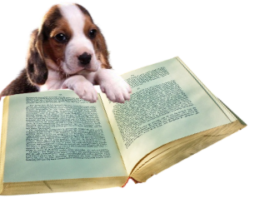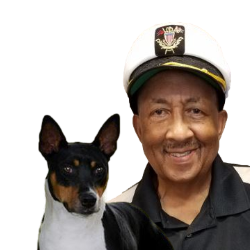How to train a Pug post may contain affiliate links. Learn more on my Affiliate Disclosure page.
You will discover here how to train a Pug successfully. Your playful, fun, and lovable Pug puppy will likely encounter problems during obedience and housetraining. Here are some tips for overcoming those problems.
Pugs are known for their charm, mischief, and affection. In addition, they have an easy temperament and tend to use funny expressions. Furthermore, they are also brilliant, making them a popular choice for a pet in a family or a single person.
Training is necessary to get a well-behaved adult Pug. However, obedient dog training can be challenging because they tend to be easily distracted, rebellious, and bored by repetition.
I recommend the Positive Reinforcement dog training method to all dog parents who plan to home-train their Pug. This dog training technique will help your Pug learn quickly and do what you ask.
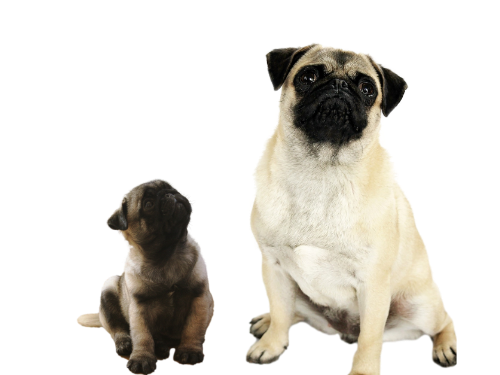
How To Train A Pug Successfully
Pugs flourish on human companionship and are an excellent choice for dog parents who live in houses or apartments. They are known to be quite affectionate. Your Pug is a ball of joy that will keep you laughing.
Pugs can be stubborn, and they want to please their dog parent, but how to train a Pug to be an ideal family member will require your attention.
Most easy-going dogs do not bark, chew, or dig excessively. Pugs usually get along with other dogs and are tough enough to be around children.
Although they enjoy clowning around and entertaining others, you must supervise them.
Despite its small size, the Pug makes an excellent companion. Unfortunately, however, the breed is prone to health problems.
Luxurious Pug History
Pugs are of Chinese origin, somewhere around 400 B.C. Their sole purpose was to serve as companion animals for wealthy people.
Pugs were considered royalty, with some of them carrying titles of rank. Some had guards and servants assigned to make them safe and comfortable.
Pugs were considered valued possessions of the rulers of China. As a result, they lived a remarkably luxurious lifestyle.
During the 16th and 17th centuries, the government also trained Pugs to be guard dogs and find people and animals.
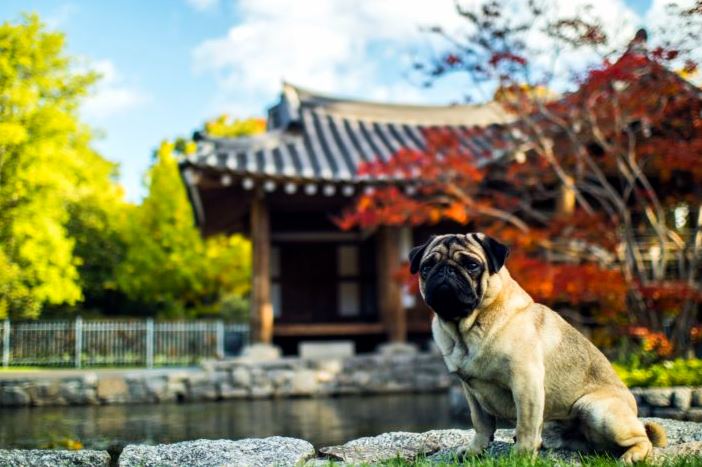
The Origin For The Name Pug
Pug originated in 1731; their squashed muzzle resembled the marmoset monkey.
Pug Popularity
The Pug's rich history extends across several continents worldwide and dates back centuries. From the ancient world to the present, Pugs have been a favorite companion of royalty throughout time.
The breed's popularity increased in the 19th century thanks to Queen Victoria's devotion. Throughout her life, she had many Pugs, including some she bred herself. Then, in 1873, Queen Victoria created the Kennel Club, which was passionate about dogs.
Pugs have gained popularity over the past few years. However, pugs are currently ranked 28th by the American Kennel Club for popularity from a list of 204 recognized dog breeds.
How To Train A Pug Characteristics
Pug Average Size ~ Life Expectancy

Pug Breed Traits
Coat Type
Typically the Pug is one of four colors: fawn, silver, black, or apricot with a black mask on the muzzle, or all black.
Pugs Possess a double coat, despite their short coats. Pug coats are fur.
Unlike most other dogs, Pugs have a shorter fur growth period, and this causes them to shed excessively compared to other breeds.
How To Train A Pug
Pros and Cons For The Breed
Pros
- Perfect for tiny homes and apartments, not yappy
- Pugs have loving and lapdog-like personalities, so they get along well with people and pets.
- Excellent indoor pet companion for less active or older adults.
- Good watchdogs without excessive yapping, which is common in some toy breeds.
- Ideal for first-time Pug parents with no or little training experience.
- Family-friendly – good with other pets, children, adults, and guests.
- A moderate amount of exercise is required.
Cons
- Pugs are not good at being left alone for an extended period. They can get depressed.
- Pugs have a low-temperature tolerance. The Pug does better when kept most of the time indoors.
- Excessive shedding a bit more than other dog breeds.
- It gains weight quickly.
- Susceptible to a variety of health issues.
- Stubborn - Obedience training can be challenging.
- Snoring during sleep.
How To Train A Pug Puppy
Your dog training skills will require patience, consistency, and bonding time with your puppy.
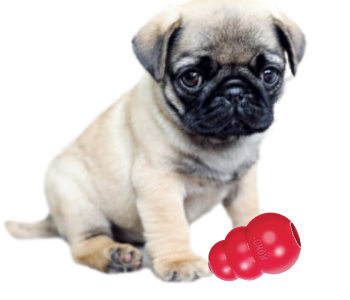
Bring Home New Puppy
So, you've decided to bring home a new fluffy bundle of joy - a Pug puppy! Congratulations, now next is how to train a Pug. You're in for an exciting adventure filled with love and laughter.
But before your little furball arrives, you must ensure you have all the necessary accessories ready to provide them with the best start in life.
First things first, let's talk about bedding. A cozy and comfortable bed is essential for your Pug puppy to have a good night's sleep. Look for a bed that provides adequate support for their growing joints and has removable covers for easy washing - trust me, accidents will happen!
Ultimate Comfort for Your Pug: Our Furhaven Orthopedic Dog Bed is designed with medium and small dogs in mind and features a plush, orthopedic foam base that provides optimal support for your furry friend's joints and muscles.
The removable bolsters add a layer of coziness, making it the perfect spot for your Pug to relax and unwind.
Next up on our checklist is food and water bowls. Pugs are notorious chowhounds, so invest in sturdy stainless steel or ceramic bowls that won't easily tip over. Additionally, consider buying elevated feeding stands, as this breed often suffers from indigestion or acid reflux.
To round off our accessory checklist, remember toys! Pug puppies are playful little creatures with loads of energy to burn.
Stock up on chew toys to help soothe teething pains and provide mental stimulation - puzzle toys work wonders too! With these essentials, you'll be well-prepared to welcome your new Pug puppy into their forever home. Happy shopping!
How To Train A Pug Using Positive Reinforcement
Pugs learn better when dog trainers use positive reinforcement training. Therefore, I use the terms "train or training" in this article to refer to the Positive Reinforcement Training Method.
What is positive reinforcement dog training?
How to train a Pug may be challenging due they can be stubborn. As a result, they sometimes get bored quickly, get distracted, or don't care about your obedience training skills.
Positive reinforcement uses a reward system that provides feedback through treats and praise for doing the correct behavior.
Professional dog trainers prefer the positive reinforcement dog training method because your Pug learns quickly to do what you ask. After all, he knows forthcoming will be a tasty treat with praises.
"Pugs don't care about getting money. Instead, they love to get treats, praises, and toys."
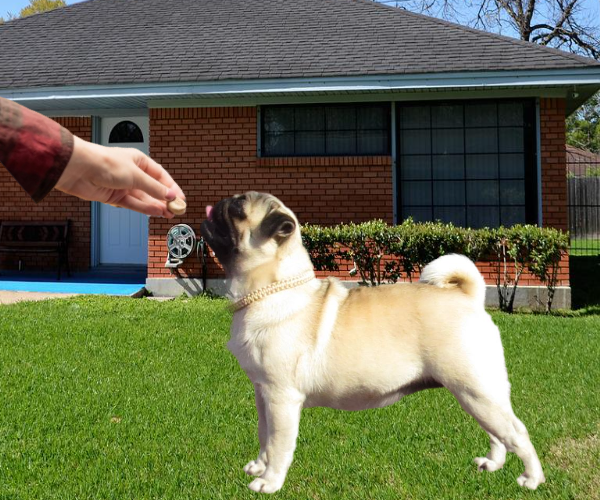
Repeat the same obedient training command repeatedly until your Pug performs the specific behavior you desire correctly with ease.
"Sit" ought to be your first training session. The sit command will set your preferences for upcoming lessons. In addition, the sit command will calm and relax your Pug.
How To Train A Pug Basic Commands
Good dog behavior happens on your dog's understanding of the how to obedience train a pug using basic commands. Therefore, it is essential for your dog to pay attention to you and to do what you ask on command.
Every Pug parent should know the following obedience dog training commands:
SIT ~ DOWN ~ COME ~ LEAVE IT
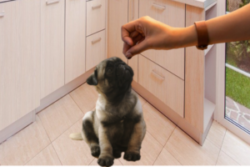
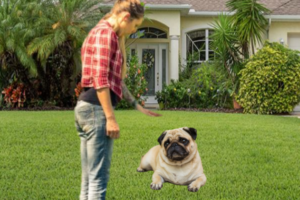
DOWN - This behavior will cause your Pug to become calm and keep him from getting into mischief.
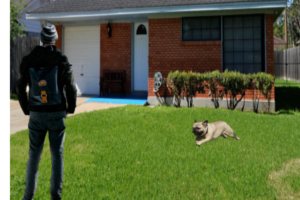
COME - This command prevents accidents (such as running off to fight with another dog, getting lost, or being hit by a moving vehicle).
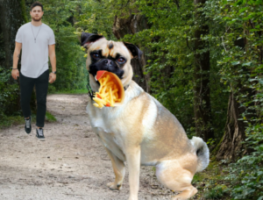
LEAVE IT - Will stop your dog from picking up objects, food items, or anything that may pose a risk for injury.
How To Train A Pug
Do's and Don'ts Dog Training
Do's
- Praise and Reward - Right away after your Pug performs the correct behavior, reward him with a tasty treat and praise.
- Training Locations Must Be Quiet - Free of noisy distractions while conducting training sessions.
- Training Time Ought To Be Short - Repetitive behavior training sessions should always be less than 15 minutes.
- Consistently - Use brief, clear verbal commands and make sure that all family members use the exact command words for the same behavior.
- Gradually Stop Giving Training Treats - You can slowly replace treats with positive praises when your Pug learns and performs your commands.
Don’ts
- Stop Correcting Unwanted Behavior - Some pet parents struggle with positive reinforcement training because they cannot stop bad behavior by saying "NO." Preventing unwelcomed behavior at an earlier age is essential to the success of dog training.
- Punish - You must never yell, scold or display a disgusting attitude while training your Pug. Negative behavior on behalf of a trainer will only delay the dog obedience training process.
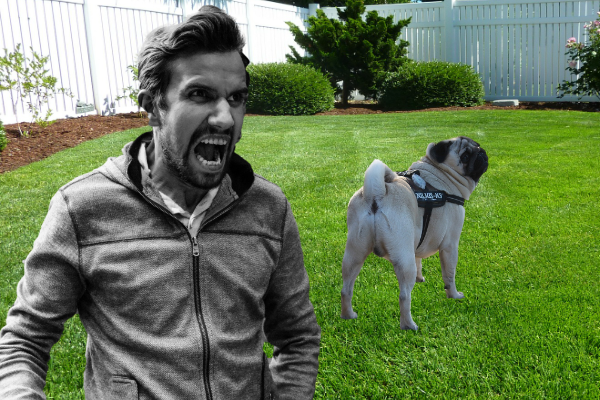
- Reward Undesirable Behavior - Example: Your Pug barks whenever he hears kids playing outside, and you let the dog out.
In this example, the dog's parent responds incorrectly to the barking.
To be effective in getting the barking to stop. First, it is crucial to ignore the barking and not let your Pug run outside. Eventually, the barking will stop.
To be effective in getting the barking to stop. First, it is crucial to ignore the barking and not let your Pug run outside. Eventually, the barking will stop.
Socialize Training For Pugs
It is vital to socialize with your Pug to continue living a happy and friendly life.
Your Pug's environment is under your control as a dog parent. However, to make sure your Pug feels comfortable and calm in their daily lives, you should familiarize them with their surroundings.
Start socializing your Pug as soon as you bring him home. Your Pug must adjust and learn about its new life, whether a puppy or an adult dog. Tips for socializing your Pug will help you turn him into a friendly, well-behaved pet companion.
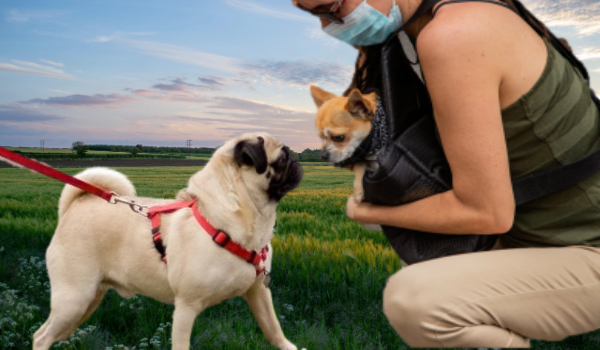
It's essential how to obedience train a pug for you to start introducing your Pug to your family, friends, and other pets as soon as possible.
How To Socialize Your Pug Puppy
- Introduce your Pug calmly to your family and friends.
- It would help if you started with your family, especially those who live with you or visit frequently.
- Make sure your Pug sniffs and plays with children.
- Allow your Pug to meet your friends.
- Permit your Pug to meet with new neighborhood dogs during daily walks.
- Make sure your dog walks around your neighborhood and becomes familiar with other dogs and pets in the area.
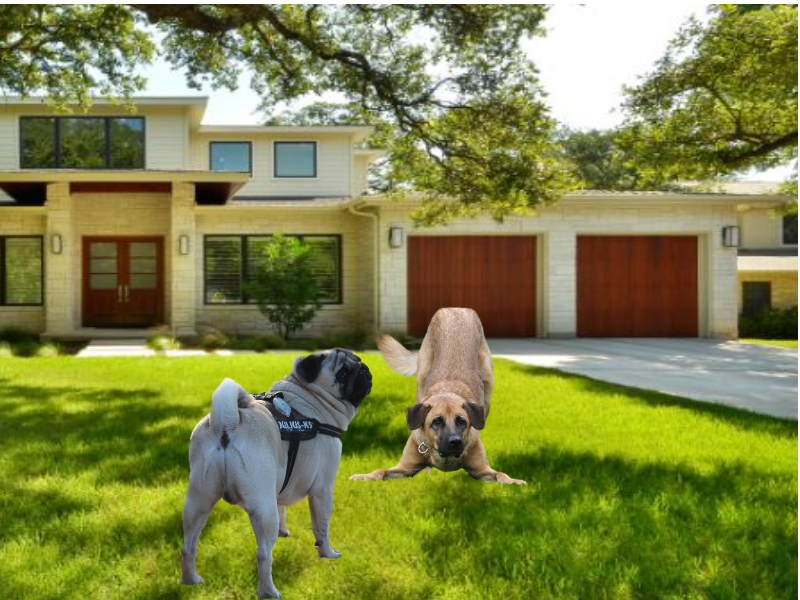
Transport and travel
- Take your Pug along with you whenever you are driving.
- Allow your Pug to experience the car in safety while being able to see out the window in a dog-safe car seat.
- You might want to consider a car crate for your Pug if it gets nervous while driving.
- A Pug's early exposure to vehicle transportation usually prevents travel anxiety.
Making Friends
- Pugs are good at socializing, and they are especially good with children.
- Give your Pug a good amount of socialization opportunities during their lifetime.
- Dog Parks offer a fantastic opportunity for your Pug to become used to other dogs and make friends.
Busy Street Traffic Areas
- Pug parents living in apartments who must walk their dogs on busy streets every day should start walking them early so they get used to the noise. Make sure your Pug walks on a leash to avoid running into traffic.
- A dog trainer must train Pugs to become comfortable in outdoor areas with food and strangers nearby.
Socializing training aims to teach your dog not to be afraid of different people, animals, and areas. Remember to constantly stay calm throughout socialization training; you can expect a well-behaved social Pug.
Pug Potty Training
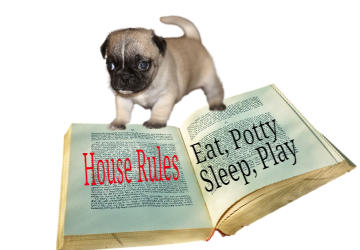
How to train a Pug to potty outside can be challenging, but with the right approach and a little patience, you can successfully teach your pup to do its business in the appropriate place.
One helpful technique is crate training. Since pugs are naturally clean dogs, they avoid soiling in their sleeping area. Using a crate just enough for them to stand up and turn around comfortably, you can create an instinctive desire in your pug to hold their bladder until you take them outside.
Consistency is also crucial when it comes to potty training your furry companion. Establishing and sticking to a schedule will help your Pug understand when it's time to go outside.
- Take them out first thing in the morning, after meals, and before bedtime.
- Use positive reinforcement such as treats or praise when they are eliminated in the designated spot to reinforce good behavior.
- Additionally, watch for signs that your pug needs to go - if they start sniffing around or circling in one spot, nature is likely calling. Quickly guide them outside before any accidents occur!
- Remember that accidents happen during the learning process, so be patient with your pup and never punish them for mistakes; instead, focus on reinforcing positive behavior consistently.
With dedication and understanding from you and your adorable pug puppy, successful potty training is within reach!
Pugs will likely experience separation anxiety if left alone in a crate for more than 1- 4 hours without human company. As a result, your Pug might sometimes become miserable, destructive, and even vicious.
Discover how to use a crate for your Pug puppy below video correctly:

Establishing a routine as soon as possible ensures your dog is well-behaved and happy. In addition, by taking action now, you will prevent the development of bad habits in the future.
How To Care For A Pug
HEALTH
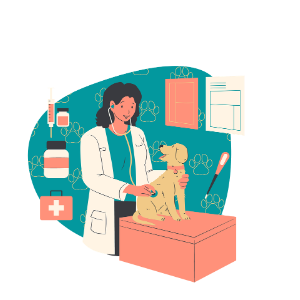
According to a Royal Veterinary College research study, Pugs are prone to serious health risks. Therefore, based on this finding, Pugs are currently not listed as "typical dogs" due to their health problems.
Pug parents should be aware of the following illnesses they may have to deal with in the future.
- Overheating. Pugs have tiny upper respiratory tracts because they are brachycephalic, so they frequently breathe through their mouths.
- Distress in the respiratory system.
- Ear infections and allergies.
- A disease of the teeth.
- Injuries to the eyes.
- Legg-Calvé-Perthes disorder.
Buy From Reputable Pug Breeders
Make sure your breeder follows the guidelines for breeding healthy Pugs. In addition, dog breeders should screen breeding dogs for the above health issues and that they follow the Pug Dog Club of America health guidelines from the Canine Health Information Center.
GROOMING
The Pug's extensive hair shedding requires regular brushing to keep its coat looking good. You should also clean the folds on the face and check its eyes and ears for debris to keep your Pug looking and smelling good.
EXERCISE
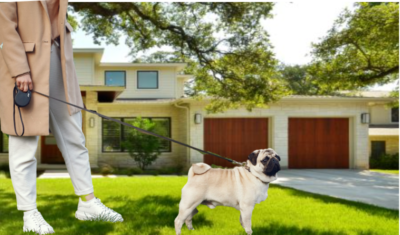
Pugs only require moderate daily exercise, usually somewhere around an hour. Take your Pug on frequent shorter walks, which include playtime and various mentally stimulating activities.
You can learn how to care for a pug dog by watching the video below.
Need Training Help For Your Pug?
Do you need help in training your furry friend? Then, sign up for this fantastic (and free) online workshop on how to train a Pug to become as well-behaved as a service dog.
K9 Training Institute Free Workshop
The K9 Training Institute offers a free workshop where you can learn firsthand their effective training methods.
The Free Workshop emphasizes building a solid bond between you and your pup. They explain how to apply positive reinforcement techniques that make learning enjoyable for dogs and their owners.
Does your dog tug on its leash, bark constantly, and won't come when called? Sign Up and get the FREE Obedience Training Workshop Now!
Conclusion: How To Train A Pug
Pug puppies are an important decision for any family who decides to get one. Here are some how to obedience train a pug tips for bringing a puppy home: watch the video below.
Since Pugs are very devoted to their pet parents, they will always be your constant shadow. As a result, if you're considering getting a Pug, you'll need to be sure that you can provide the attention your puppy will need.
